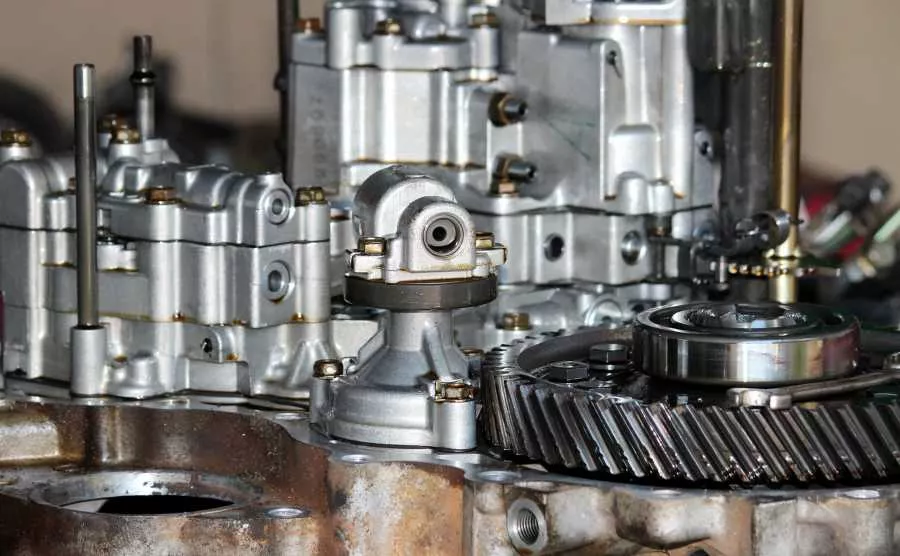What is transmission fluid?
Like engine oil, transmission fluid is on the list of your car’s essential items. Simply put, it’s used to lubricate the moving metal parts inside your gearbox that come into contact with each other.
Whether your car is a manual or an automatic, the principle is the same: the engine’s output is sent through the transmission, where an array of gears takes the narrow powerband and expands it into something that’s far more usable before sending it to the wheels.

Transmission fluid bathes the gears in lubricant to reduce friction and extend the life of gearbox components
All that involves friction and heat since the gears grind against each other, eventually wearing themselves out in the process. Transmission fluid bathes these grinding surfaces in the lubricant, mitigating the effects of friction while helping extend the life of the transmission’s components.
Crude oil is a standard base ingredient for transmission fluid, but there are also those made from synthetic materials, making them more resistant to degradation during high temperatures.
Manual transmission fluids typically have a dark color and are thicker or more viscous, while fluids for automatic transmissions are thinner and have a clearer hue with a tinge of red.
Some types of automatic transmission fluid come in other colors as well, making them easier to tell apart from engine oil and other liquids flowing through the car’s innards. It’s certainly helpful when spotting a leak.
>>> Related: Transmission fluid guide: What color is it supposed to be?
What is power steering fluid?
Many cars released within the last two decades or so use electric-assisted power steering or EPAS, where the vehicle’s electrical system provides steering assistance, usually through electric motors.
Meanwhile, the vast majority of older cars still rely on a hydraulic setup to amplify the force exerted on the steering wheel, using a pump powered by the engine. This is where the power steering fluid comes in.

Smoother steering is possible through the use of power steering fluid
The fluid helps create pressure exerted on both sides of the car’s steering pistons, which provides for a smooth turn of the wheels. Like transmission fluids, the power steering fluid comprises either mineral or synthetic components, the latter having additives blended in to improve lubrication and resist corrosion inside the steering components.
>>> Related: Top 4 essential fluids in your car
Differences between power steering fluid and transmission fluid
- Transmission fluids, especially those for automatic gearboxes, are used for cleaning the transmission components. For power steering fluid, the main purpose is to lubricate the power steering parts, reduce temperature buildup, and apply hydraulic pressure to facilitate steering.
- Transmission fluids are blended with detergents and friction modifiers. Even while the latter can help control the heat buildup inside the power steering valves and pump, the former could damage the steering rack’s hydraulic valves.
- Both fluids come in a variety of colors that darken with use. Transmission fluid has a sweet odor, while power steering fluid’s smell has been described as similar to a burnt marshmallow.
Can you use transmission fluid for power steering fluid?
You might be tempted to think that transmission fluid can be used as a substitute for power steering fluid since they both have lubricating properties.
How to Change EVERY FLUID in your Car or Truck (Oil, Transmission, Coolant, Brake, and More)
What needs to be taken into consideration, however, are the specific requirements since the steering and transmission involve different materials.

Both fluids may have similar properties, but they are formulated for different purposes
>>> Related: 7 things need to know when taking care of your power steering system
As mentioned, the friction modifiers blended into transmission fluids can end causing damage to the power steering pump. This is why some manufacturers explicitly prohibit the use of transmission fluid as a substitute for power steering fluid, so it bears checking the car manufacturer’s recommendation before proceeding.
Transmission fluid can be substituted for power steering fluid in older vehicles, especially those made in the 1970s or earlier. This is because they didn’t have the same lightweight and modern materials found in cars assembled during the 1990s onward.
In contrast, while newer cars use more advanced engineering, they also use more delicate components. The different systems are designed to use fluids that are specifically blended to their unique requirements.
Mainstream models can probably withstand the negative effects of the swap, while more premium makes are more sensitive and vulnerable.

Owners of more expensive cars are advised not to interchange the two fluids
The best way to determine if it’s safe to switch fluids is to consult the owner’s manual, where it mentions whether a car’s power steering system can safely accommodate transmission fluid or not.
In case it’s allowed, the manufacturer might require only a specific type of transmission fluid as a suitable substitute. Emergency cases are probably the only instances where you can pour in transmission fluid in lieu of power steering fluid. Make sure you completely flush out the transmission fluid and put in the power steering fluid as soon as you can.
FAQs about power steering fluid vs transmission fluid
Q: Is the power steering fluid the same as the transmission fluid?
A: No. Each fluid is formulated for a specific purpose. Transmission fluid is formulated to lubricate and clean the transmission, while power steering fluid is intended to exert hydraulic pressure on the steering system to make turns easier.
Q: Does power steering fluid require changing?
A: Yes. Over time, power steering fluid can accumulate dirt, moisture, and other contaminants that can reduce its effectiveness and even damage the power steering system. The fluid can also undergo oxidation. Degraded power steering fluid can cause the steering pump to make noise during operation, and extreme cases will make it give out entirely, compromising maneuverability and safety.
Q: How frequently should power steering fluid be changed?
A: Typically, two years is ideal under normal use. With heavier usage, the interval is usually between 120,000 and 160,000 km.
Get more automotive tips at Philkotse.com.
Recent posts
- Low brake fluid symptoms causes Feb 18, 2021
- car won't start steering wheel locked Feb 09, 2021
- Everything you need to know about D.I.Y. washer fluids Apr 15, 2020
- Dispose of your car fluids properly Nov 30, 2022
- Everything You Need To Know About Brake Fluid Aug 17, 2022












